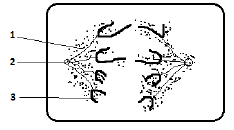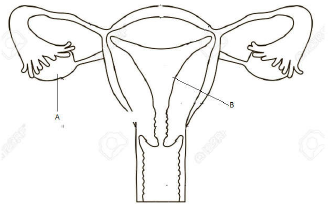Students can refer to the following Sample Paper ICSE Class 10 Biology Set F with Answers provided below based on the latest syllabus and examination guidelines issued for ICSE Biology. All specimen papers have been prepared covering all chapters given in ICSE Biology book for Class 10. You should also refer to ICSE Class 10 Biology Solutions.
Sample Paper ICSE Class 10 Biology Set F with Answers
Grade: X
Subject : Biology
• You will not be allowed to write during the first 15 minutes.
• This time is to be spent in reading the question paper.
• The time given at the head of this paper is the time allowed for writing the answers.
• This paper consists of 7 printed pages.
• Attempt all questions from Section I and any four questions from Section II.
• The intended marks for questions or parts of questions are given in brackets [ ].
Section I (40 Marks)
Attempt all questions from this section
Question I
(a) Name the following: [5]
(i) The phenomenon by which living or dead cells absorb water by surface attraction.
(ii) The part of the brain associated with memory.
(iii) The type of gene which in the presence of contrasting allele is not expressed.
(iv) The process of conversion of ADP into ATP during photosynthesis.
(v) The term used for mature follicle in females.
(b) In each set of terms given below there is an odd term. Find the odd term and state the category to which the other three belong: [5]
(i) Thymine, Cytosine, Adenine, Pepsin.
(ii) Cortisone, Somatotropin, Adrenocorticotropic hormone, Vasopressin.
(iii) Flyash, needles, dirty dressings, discarded medicinal tablets.
(iv) Diffusion, guttation, osmosis, active transport
(v) Gibberellins, calcitonin, cytokinins, abscisic acid
(c) Given below are certain special functional activity. Write the special structure/secretion with which it is concerned: [5]
(i) Area no vision
(ii) Connects middle ear to the back of the throat
(iii) Protein synthesis
(iv) Regulates the exchange of respiratory gases in plants.
(v) Stimulates secretion of milk
(d) Observe the diagram given below and answer the questions that follow:

(i) Which stage of cell divisions is shown in this figure? Justify your answer.
(ii) Name the parts labelled 1 and 3.
(iii) State the number of pairs of chromosomes in the figure.
(iv) Name the stage of cell division that succeeds the stage shown in the figure.
(e) Explain the following terms: [5]
(i) Ultrafiltration
(ii) Tropic movements
(iii) Myelin sheath
(iv) Theory of use and disuse
(v) Master gland
(f) Select one suitable word to fill the blanks from the three alternatives given in the bracket and rewrite the same: [5]
(i) The organism studied for industrial melanism was a ___________________.
(butterfly, honey bee, moth)
(ii) An organelle which produces ribosomes is ______________.
(nucleus, nucleolus, endoplasmic reticulum)
(iii) The respiratory centre is located in the _________________.
(cerebrum, hypothalamus, medulla oblongata)
(iv) The plant hormone that stimulated closing of stomata is ________________.
(Auxins, Abscisic acid, Ethylene)
(v) Swachh Bharat Abhiyan was launched on _____________.
(2nd September 2014, 16th September 2014, 2nd October 2014)
(g) State the locations of the following structure or the parts: [5]
(i) Mitral valve
(ii) Lenticels
(iii) Vagina
(iv) Thyroid gland
(v) Ciliary body
(h) Given below are a set of 15 biological terms. Of these 12 can be paired into 6 matching pairs. Of the six, one has been done. Write down the remaining five pairs:
Example – Adenosine triphosphate – Energy molecule
Section II (40 Marks)
Attempt any four questions from this section
Question 2
(a) Draw neat labelled diagrams of the following: [5]
(i) Membranous labyrinth
(ii) Plasmolysed plant cell
(b) Answer the following in one sentence each: [5]
(i) Expand the following – ODF India.
(ii) Which chemical is used to show the presence of starch in leaves?
(iii) Why did Mendel select pea plants for his experiments?
(iv) What is double circulation?
(v) Name the three great cultural revolutions that favoured a steep rise in population.
Question 3
(a) The given diagram shows and experimental set up of a process. Study the same and answer the questions that follow:

(i) In which plant A,B or C would water move up the fastest?
(ii) In which plant would water move slowly and why?
(iii) Why is water covered with oil?
(iv) What is the purpose of this experiment?
(b) Distinguish between the following based on the criteria given in the bracket: [5]
(i) Natality and Mortality (definition)
(ii) Renal cortex and Renal medulla )parts of nephrons present)
(iii) Australopithecus and Cro magnon (cranial capacity)
(iv) Karyokinesis and Cytokinesis (dividing part of the cell)
(v) Artery and Vein (thickness of wall)
Questions 4
(a) Following is the representation of a cross showing inheritance of haemophilia. Study the cross and answer the following:

(i) What is the ration of carrier and haemophilic offspring?
(ii) What is the ratio of normal boy and haemophilic boy?
(iii) What is the phenotypic ratio of normal and haemophilic offspring?
(iv) What is haemophilia?
(v) Define the term “Sex linked inheritance.”
(b) Give biological reasons for the following: [5]
(i) Children of tall parents may be short.
(ii) Red blood cells are best suited for transportation of oxygen.
(iii) One can tie shoe laces without seeing.
(iv) Twins may or may not be identical.
(v) A higher rate of transpiration is recorded on a windy day than on a calm day.
Question 5
(a) Look at the diagram given below and answer the questions that follow:

(i) Name the parts labelled A and B.
(ii) Name the hormones produced by ‘A’
(iii) State the fate of part labelled ‘B’ in the following cases.
1) If Fertilization takes place
2) If fertilization does not take place.
(iv) Where does fertilization occur?
(b) Study the diagram given below and answer the questions that follow: [5]

(i) What is the aim of the experiment?
(ii) Write the characteristics feature of the cobalt chloride paper used to serve the purpose of this experiment.
(iii) Why glass slides are attached to the cobalt chloride papers placed above and below the surface of leaves?
(iv) State your observation for set up A and set up B after an hour and give reason to support your answer.
(v) Define the process taking place in the above set up.
Question 6
(a) The diagram given below represents the human heart in one phase of its activity. Study the same and answer the questions that follows: [5]

(i) Name the phase.
(ii) Which part of the heart is contracting in this phase?
(iii) Name the phase numbered 1 and 2.
(iv) What type of blood flows through the parts marked 1 and 2?
(v) Which valves are closed in this phase?
(b) State one main function of the following: [5]
(i) Antidiuretic hormone
(ii) Auxins
(iii) Placenta
(iv) Lacrimal gland
(v) Mesophyll cells
Question 7
(a) Answer the following: [5]
(i) With the help of a flow chart, write down the process of reflex action.
(ii) State whether the following are simple or conditioned reflexes.
1) coughing
2) watering of mouth on seeing a favourite dish
3) closing of eyes when a strong beam of light flashes across
(b) Give appropriate biological term for the following: [5]
(i) Knot like mass of blood capillary inside Bowman’s capsule.
(ii) Splitting of water molecules into hydrogen ions and oxygen in the presence of light.
(iii) Endocrine part of the pancreas.
(iv) Liquid waste from domestic activities.
(v) Slow and continuous process where complex forms emerge from simpler forms.